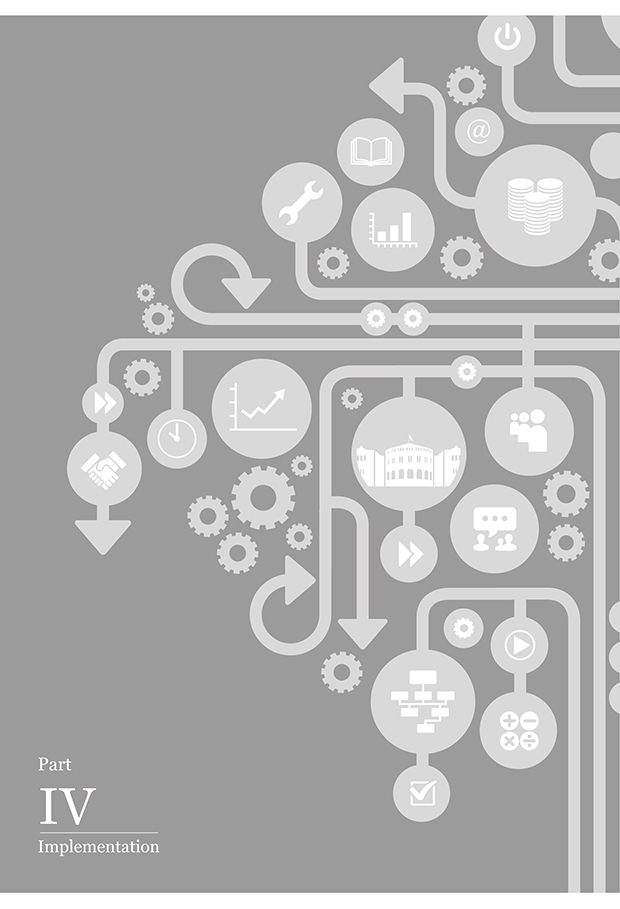Part 4
Implementation
12 Responsibility, follow-up, and realisation

Figure 12.1
Digital Agenda highlights the priority areas for promoting value creation and innovation by means of ICT.
The Ministry of Government Administration, Reform and Church Affairs has overarching responsibility for coordinating ICT policy. This role involves acting as a driver for key areas related to the information society, responsibility to identify and follow up cross-sectoral issues, and responsibility to initiate and coordinate cross-sectoral initiatives. This work entails preparing overviews and strategies for national ICT policy.
ICT policy is closely linked to several other policy areas. This white paper has therefore been prepared in cooperation with several ministries. The ministries are responsible for ICT within their respective areas. This means that, for example, the Ministry of Education and Research has responsibility for ICT policy in the areas of competence and education, the Ministry of Transport and Communications for ICT policy in the areas of transport and communications, and the Ministry of Culture for ICT policy in the areas of culture and media.
Overarching responsibility for following up many of the initiatives presented in this white paper and in the relevant policy areas lies with ministries other than the Ministry of Government Administration, Reform and Church Affairs. The Ministry of Government Administration, Reform and Church Affairs will, nevertheless, have overarching responsibility for following up progress and results, in dialogue with the other ministries.
This white paper has also been based on dialogue and communication with external stakeholders such as individual enterprises, non-profit organisations, interest groups, and representatives of academia and the R&D community. The Government will build on this cooperation in following up on the white paper. The Government will therefore create forums and networks on important issues discussed in this white paper.
The Government wants the white paper on Digital Agenda for Norway to be relevant to business and industry, interest groups, decision-makers in the public and private sectors, academia, the R&D community, volunteers, and civil society.
The Government will be following developments over time of ICT’s spread throughout society and how ICT creates growth and value creation.
ICT development is, by its very nature, a cross-sectoral phenomenon, meaning that ICT trends in Norway will largely follow international trends and genesral international conditions. The Government will therefore place importance on international programmes and projects at Nordic level, in the EU and OECD, and through dialogue with individual countries.
Textbox 12.1 Initiatives
103. Indicators and statistics on ICT trends
The Ministry of Government Administration, Reform and Church Affairs will prepare statistics and indicators on ICT trends.
13 Economic and administrative consequences
The white paper on Digital Agenda for Norway outlines how the Government will enable Norway as a society to exploit the possibilities that ICT and the internet offer for value creation and innovation.
Several studies show that use of ICT, and of the internet in particular, contributes positively to economic development and acts as a catalyst for growth and innovation. An OECD study from 2012 summarises the results from multiple studies showing that increased broadband penetration contributes positively to GDP growth.1 According to another study conducted by researchers at the University of Groningen, 50 per cent of Europe’s productivity growth between 2004 and 2009 was attributable to use of ICT.2 An analysis undertaken by McKinsey in nine countries (Sweden, Germany, UK, France, South Korea, Canada, Italy, and Japan) estimates that 21 per cent of GDP growth in the past five years alone can be attributed to the internet.3 We can make a calculation to illustrate what this means for Norway. GDP for mainland Norway grew by 9.6 per cent between 2006 and 2011, measured in constant prices. If we make a conservative estimate that 10 per cent of this growth is attributable to the internet, this is equivalent to almost NOK 17 billion (in 2011 kroner).
A Norwegian study shows a positive connection between use of ICT and work productivity in business and industry.4 The results also show that there are positive interaction effects between use of ICT and employees with higher education. These can be interpreted to mean that the benefits a company derives from ICT increase if the company’s employees have higher education.
This white paper discusses a range of initiatives with potentially beneficial effects for stakeholders in the private and public sectors and for society. Many of these initiatives will also entail costs that must be weighed against short-term and long-term gains. Gains often occur in places other than those where investments are made, and often years later. Estimating effects can therefore prove difficult. Many of the initiatives presented in this white paper involve assessing the need for, and design of, changes in policy. Future reporting will discuss the economic and administrative consequences of relevant initiatives. The costs of the initiatives described in this white paper will be covered by the budgets of the ministries involved.
Footnotes
Stryszowski, Piotr (2012): The Impact of Internet in OECD Countries, OECD Digital Economy Papers, No. 200, OECD Publishing
Ark, Bart van and Robert Inklaar (2005): Catching up or Getting Stuck? Europe’s Troubles to Exploit ICT’s Productivity Potential, Groningen Growth and Development Centre, University of Groningen
McKinsey Global Institute (2011): Internet matters: The net's sweeping impact on growth, jobs, and prosperity
Rybalka, Marina (2008): Hvor viktig er IKT for utviklingen i næringslivet: produktivitetsanalyse [How important is ICT for development in business and industry?: A productivity analysis], in Økonomiske analyser 5/2008 (SSB)